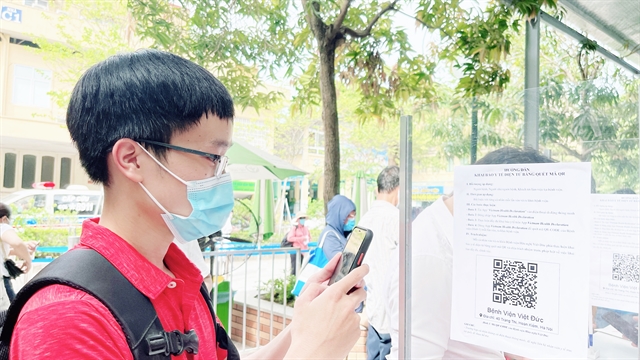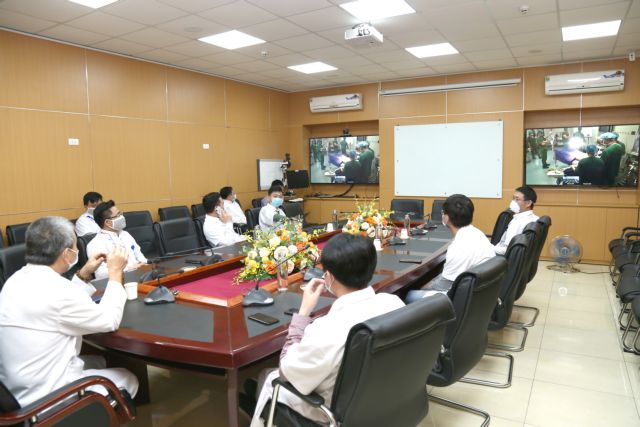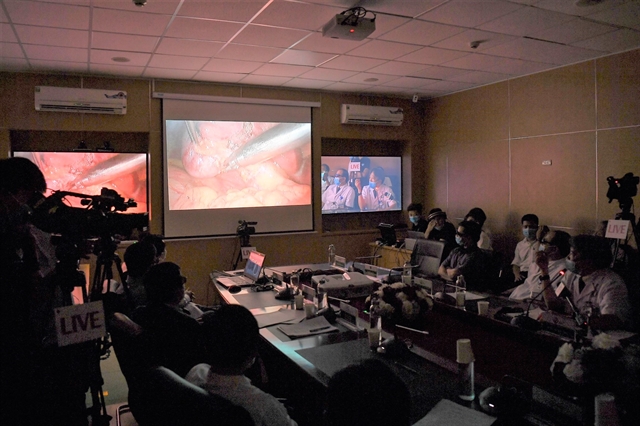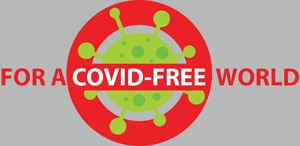 Opinion
Opinion

Speaking to Vân Nguyễn from Việt Nam News, Dr. Đỗ Mạnh Hùng, Deputy Head of General Planning Department and surgeon of Spine Surgery Department at Việt Đức University Hospital, discusses how the hospital is using technology in health checks, treatment and cooperation in diagnosis amid the COVID-19 pandemic.

|
| A visitor scans the QR code to complete health declaration before visiting Việt Đức University Hospital. — Photo courtesy of the hospital |
Speaking to Vân Nguyễn from Việt Nam News, Dr. Đỗ Mạnh Hùng, Deputy Head of General Planning Department and surgeon of Spine Surgery Department at Việt Đức University Hospital, discusses how the hospital is using technology in health checks, treatment and cooperation in diagnosis amid the COVID-19 pandemic.
The COVID-19 pandemic has changed the technology adoption in the health sector. How has Information Technology been applied at the hospital amid the pandemic?
Việt Nam is experiencing the fourth wave of COVID-19 infection with many complicated developments that can put health establishments at a very high risk of transmission.
As a leading special-class surgery hospital in handling the most emergency and severe cases, Việt Đức University Hospital has received a great number of patients, many of whom were in severe conditions upon arrival. In April this year alone, the hospital received over 29,000 patients and in May, due to the new wave of infections, the number decreased to 12,120. The number of inpatients were 8,754 and 5,714 respectively.
The risk of disease transmission at hospitals is huge and can come from both patients and hospital staff. COVID-19 prevention and control requires strict protocols and close compliance. Proper implementation of technology has helped a lot in this work. The hospital are utilising successfully and effectively four main technology solutions, namely the use of QR code in health declaration, online appointment booking service, virtual meetings and training and most notably, telemedicine.
Many hospitals have leaned on telemedicine to cope with emergency cases amid the COVID-19 pandemic. How has this been done at the hospital?
One of the highlights in our technology solutions is telemedicine. The remote diagnosis and treatment via telecommunications technology has been proven very effective, especially amid the pandemic.
In 2020, a hospital in Quảng Ninh Province asked for our support for a myocardial rupture case who was in extremely severe conditions with blood clots in the pericardium (rupture of left atrium and right ventricle, large rupture of left pericardium communicating with left pleura). Surgeons of our hospital considered this a very rare case. If the patient had been transferred to the hospital, it might have proved fatal in transport due to blood loss. It was impossible for our medical team to travel from Hà Nội to Quảng Ninh in time to perform the surgery.
Thanks to the technology, we could gather experienced doctors to make remote diagnosis and guidance for the surgery. Leading specialists of the hospital, including Prof. Dr. Trần Bình Giang, Associate Prof. Dr. Nguyễn Hữu Ước, Chief of Cardiovascular and Thoracic Centre of the hospital, along with top anaesthesiologists made remote diagnosis and consultations as well as offered detailed guidance and followed every moment of the surgery. Our experts instructed the doctors in Quảng Ninh to perform technical procedures and eventually it could be said that the surgery was successful.

|
| Doctors of Việt Đức University Hospital gather for a telemedicine session. — Photo courtesy of the hospital |
This is a great example to demonstrate how effectively and rapidly the proper uses of IT can help the treatment for patients in such rare circumstances.
Another case was the British pilot who had to rely on ECMO last year. Leading specialists of top-notched hospitals across Việt Nam held regular online meetings to discuss his conditions. A lung transplantation was also planned for this particular case under the Ministry of Health’s instruction. We formed very close coordination with the Ministry of Health and other health establishments such as Chợ Rẫy Hospital, the National Hospital for Tropical Diseases and Việt Đức University Hospital. We then looked for lung donors and were ready to assist the transplantation upon the health ministry’s direction.
Technology helped to eliminate geographical barriers and so we can make timely diagnose for patients. For the British pilot case, luckily after he was transferred to Chợ Rẫy Hospital, the treatment made him make positive progress and he was discharged from the hospital and returned to his home country without the need to have a lung transplantation.
How have meetings and training been held amid COVID-19?
COVID-19 pandemic has changed the way we organise meetings and training courses. During the high peak of COVID-19, in-person gatherings were prohibited. Instead, we opted for online platforms such as Zoom or Google Meet to organise meetings among staff or with other health facilities. We also took advantage of our e-office system, allowing most documents to be shared via this system. This helps to reduce contacts and risk of transmission within medical personnel. Staff training, technology transfer and experience sharing have also been conducted online. Starting from 2021, the hospital has accelerated the application of IT in health checks, treatment and training.

|
| The remote diagnosis and treatment via telecommunications technology has proven to be effective, especially amid the COVID-19 pandemic. — Photo courtesy of the hospital |
What about the use of technology in health declaration and vaccination?
Following the guidance from the health ministry, the hospital has requested all patients, visitors and medical workers to make health declaration before entering and leaving the hospital. Each person has to scan a QR code to access the form with their mobile phone. After submitting the completed form, they will receive a confirmation with a QR code, which will be required by hospital staff at the screening booth. Medical workers can re-check the declared information registered on the digital systems. They will use a bar code reader to display the health declaration form on the computer and let them in. The use of QR is effective, rapid and precise. The hospital also set up five computers in the screening area to assist the digital declaration process.
In terms of vaccinations, we administered about 3,500 doses of COVID-19 vaccines and have successfully handled cases with reactions. There were only two cases with moderate reactions such as difficulty breathing, vomiting and dizziness. We have treated them in accordance with the recommendations and guidance of the health ministry and vaccine manufacturer. After the vaccination of the first dose, we have used a software to do a survey on unusual symptoms of vaccinated people and the data will be used for a scientific study. VNS

|




